
Assorted Cacti
Listen to the Cacti Podcast here!
Contents
- Top Tips
- Location, Water, Humidity & Fertilisation
- Dormancy Care & Achieving Flowers
- Common Issues
- Origins, Temperature, Propagation, Repotting & Toxicity.
Need the answer to a specific plant query? Book a 1-to-1 video call with Joe Bagley, the website's friendly author to overcome and address your niggling problem! Available on iMessage, WhatsApp, Facebook Messenger & more.
Top Tips & Info
- Care Difficulty - Easy
- Cacti must endure periods of droughts in between waters - if you're stuck with when to water it, think of the ukhouseplants' phrase of 'Drenches Between Droughts'.
- Be careful when watering - allowing excess moisture to sit in the cubbyholes of the stem will result in diseases like southern blight and 'basal rot'.
- A few hours of morning or evening sun is mandatory for all desert Cacti, especially in the winter months. If you decide to bring it outdoors, offer a sheltered location until the plant acclimates to the sunlight for the prevention of sun-scorch. Bring it back indoors once the nighttime temperatures dip to 12°C (54°F).
- Feed every six to eight weeks, using either a 'Cactus' or 'Houseplant' fertiliser.
- Keep an eye out for Mealybugs that'll form white cottony webs in the cubbyholes.
- Repot every two to four years during the spring, using a 'Cactus & Succulent' potting mix.
Location & Light - 🔸🔸🔸🔸
Place the specimen in the brightest location as possible. A few hours of sunlight per day is highly beneficial as it'll significantly reduce the risk of over-watering and root rot. Due to the intolerance to low light, avoid placing one in areas where a newspaper can't be read without the use of artificial light.
If you've recently purchased a Cactus, chances are it hasn't acclimatised to the potential direct sunlight you'll give it. If you're interested in placing yours in a brighter environment, gradually increase the light levels over a few weeks to prevent the risk of environmental shock or sun-scorch.
Water - 🔸
The ukhouseplants' rule of 'droughts between drenches' strongly applies to all desert Cacti. In the growing period, allow ALL of the soil to dry out in between waters, reducing this to every eight to ten weeks in the autumn and winter for its dormancy. Under-watering symptoms are usually uncommon; however, crispy and stunted growth are possibly due to either forgetfulness or too much sunlight. Over-watering symptoms include root and stem rot, mushy yellow leaves or a rotten stem. These issues can be corrected by removing the plant out from its pot and inspecting the rootball or soil. Are the roots brown and mushy? If so, remove the affected roots and replace the soil with a well-draining potting mix ('Cactus & Succulent' compost is best). If the bottom of the stem is mushy, it's game over - the 'heart' of the plant has rotted, meaning that revival is minimal. Cacti are more likely to suffer from over-watering if they're situated in a dark location or overly-moist soil.
Humidity -
This is not a factor; however, a quick hose down from time to time will reduce dust particles or pests on its body.
Fertilisation - 🔸
Feed with a 'Cactus' labelled fertiliser every two months in the growing period, reducing this to every three in the autumn and winter. Whilst the specimen is in bloom, switch to a product high in potassium to prolong the duration of flowers - a good example of this would be a 'Poinsettia' or 'Tomato' labelled Feed. Although a 'General Plant' fertiliser is acceptable, you'll run the risk of burning the roots if over-applied, especially with the combination of a 'ready-to-use' product and dry soil.
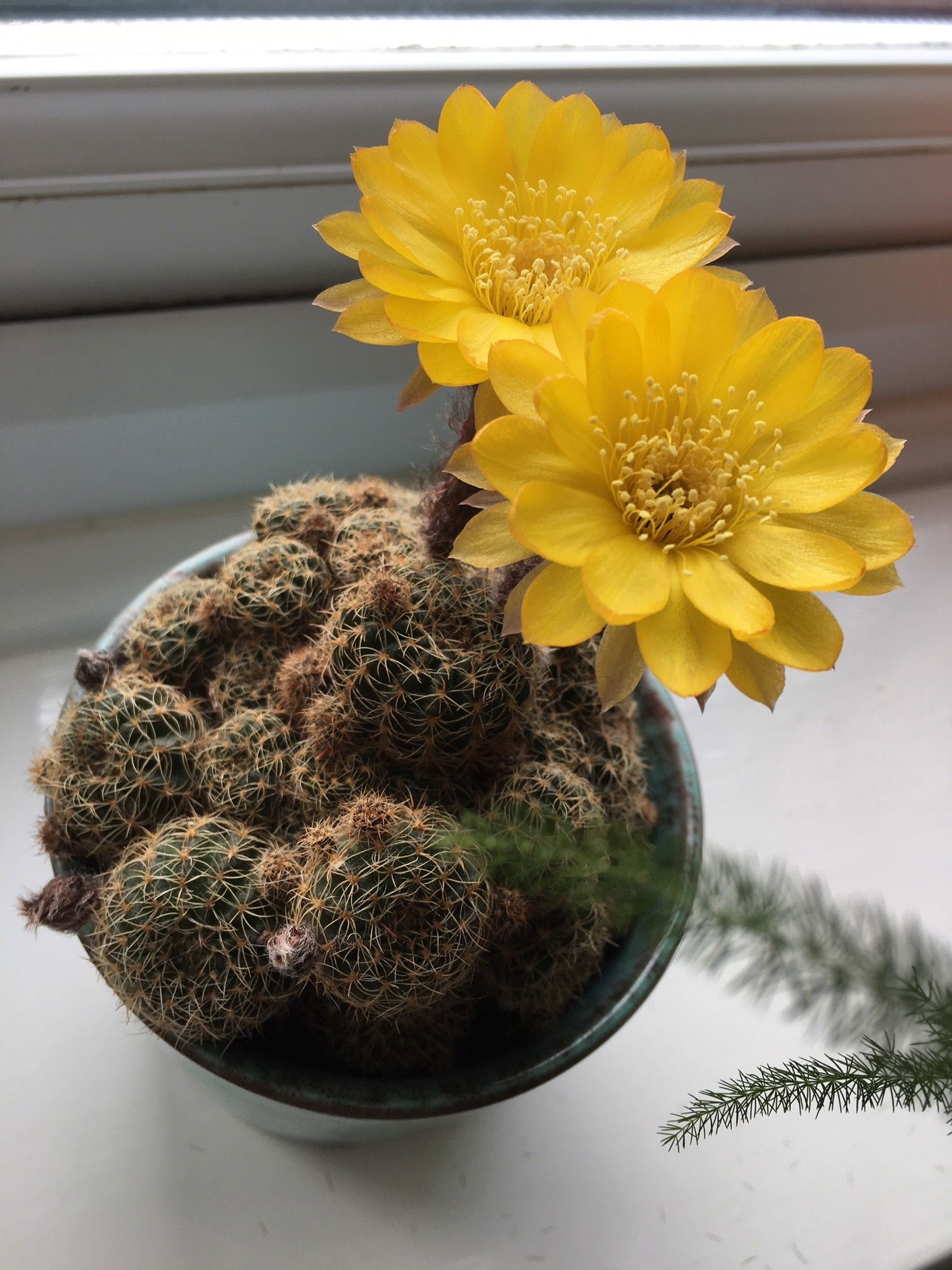 The following section is tailored for certain species that may flower in the spring or summer months.
The following section is tailored for certain species that may flower in the spring or summer months.
Dormancy Care & Achieving Blooms
Unfortunately, not all Cacti will actively flower between the months of spring and summer. Species of Mammillaria, Gymnocalycium, Notocactus, Parodia & Rebutia are most likely to bloom, producing small flower buds from mid-spring onwards.
Provide a cool autumn and winter period around 15℃ (59℉) to reinforce its dormancy. Keep the roots pot-bound to add further stress onto the specimen, which in turn will significantly heighten the chance of flowering. Blooms will generally appear in the summer, during the active growth season. The following steps should be taken from early autumn until the end of winter.
Sunlight & Location
Be sure to provide a bright location with a few hours of direct sun. Although the winter rays won't necessarily hurt the plant, be careful not to fall in the trap of sun-scorch and severe dehydration. Avoid deep shade and the use of artificial lighting at night or locations that boast temperatures higher than 18℃ (64℉).
Hydration
Reduce waters so that ALL of the soil becomes dry for several weeks. It's essential to keep them on the drier side to life, as they'll think that hard times are ahead and therefore will need to pass its genes on to the next generation.
Occasional Feeds
During the autumn and winter, fertilisation should be performed every two months with a 'Cactus' labelled feed. While the flowers are in development or in bloom, use a 'Tomato' fertiliser to provide fortnightly nourishment of potassium, at monthly intervals.
Reduce Everything
This is to remind you that everything needs to be reduced - especially the watering and temperature.
Temperature
This is the most significant step; reduce the temperature down by around 5℃ compared to the summertime or place in a room that's between 10º - 15℃ (50º - 59℉). You'll be at a significant disadvantage if the ambient temperature is kept constant throughout the year, as Cacti will only respond in locations that have daily fluctuations of around 7℃. Never exceed the minimum temperature as it may lead to plant death or yellowed foliage at a bare minimum. If these steps are followed successfully, you could see a show of blooms in the following summer - but remember, dealing with nature may not always provide the results you'd relish!
| Time of Year | Care Requirements |
| January & February | Resting/Dormancy Period. Reduce irrigations and fertilisation. |
| March | End of Resting/Dormancy Period. Increase waters and feed using a 'Cactus' fertiliser every six weeks. |
| April | Pre-Flowering Period. Swap to a potassium-based feed (like 'Tomato' feed) during this period. Continue to hydrate once ALL of the soil dries out. |
| May - July | Flowering Period. Use a potassium-based feed at six-weekly intervals during this period. Again, rehydrate once ALL of the soil dries out, but more frequently than in the winter. |
| August & September | Follow the previous section's information, but revert back to a 'Cactus' feed. |
| October - December | Resting/Dormancy Period. Reduce irrigations and fertilisation considerably. |
Common Issues with Desert Cacti
If you still can't find the answer to your specific houseplant problem, book a 1-to-1 video call with Joe Bagley to point you in the right direction today.
Over-watering is the most common issue, with typical signs including a softened yellow stem and stunted growth. There must be periods of droughts to replicate the habitats of the American deserts, as well as limiting the chance of diseases. Avoid waterlogging as there's no point fulfilling the phrase 'drenches between droughts' if the base of the pot is submerged. For more information about over-watering related issues, be sure to click on this link.
A pale centre and deformed growth are typical signs of too little light. Offer at least an hour of direct sunlight, especially in the winter months, to provide the vital nutrients that'll be converted into plant sugars.
Scorched or browned edges are the result of too little water and over-exposure to the sun. Although Cacti are a superb choice for plants in sunny locations, those that haven't acclimatised to the harsh rays will show signs of sun-scorch and environmental shock. Gradually increase the amount of light every week, starting from an indirect location to a few hours of morning/evening sun over the course of a few weeks. Prolonged exposure will significantly speed the process of dehydration, so consider transplantation into a bigger pot (in the spring) to wrap the roots around moister soil.
Over-supplementing a Cactus will bring nothing but grief in the likes of yellowing leaves and weak, dramatic growth. Although a six-weekly feed is an excellent way to promote good health, dry soil and fertiliser salts will quickly lead to the burning of roots. The advice for this issue is to pre-moisten the soil beforehand and reduce the frequency of fertilisations somewhat.
'Corking', or a hardened brown base (pictured below) is part of the ageing process for a Cactus. If those sections are hard and don't give way when applying pressure, everything is okay. If, however, the base has become soft, action must be taken quickly. Take the plant out of the pot and inspect its root system. If it's brown and mushed over, you'll have to discard it as the plant has collapsed from the inside out. For those that still have good root systems, keep the plant under-watered and provide a bright location with a hint of direct sunlight. The recovery process will be long, and sometimes not even successful - give it a go and see if you can resuscitate it!
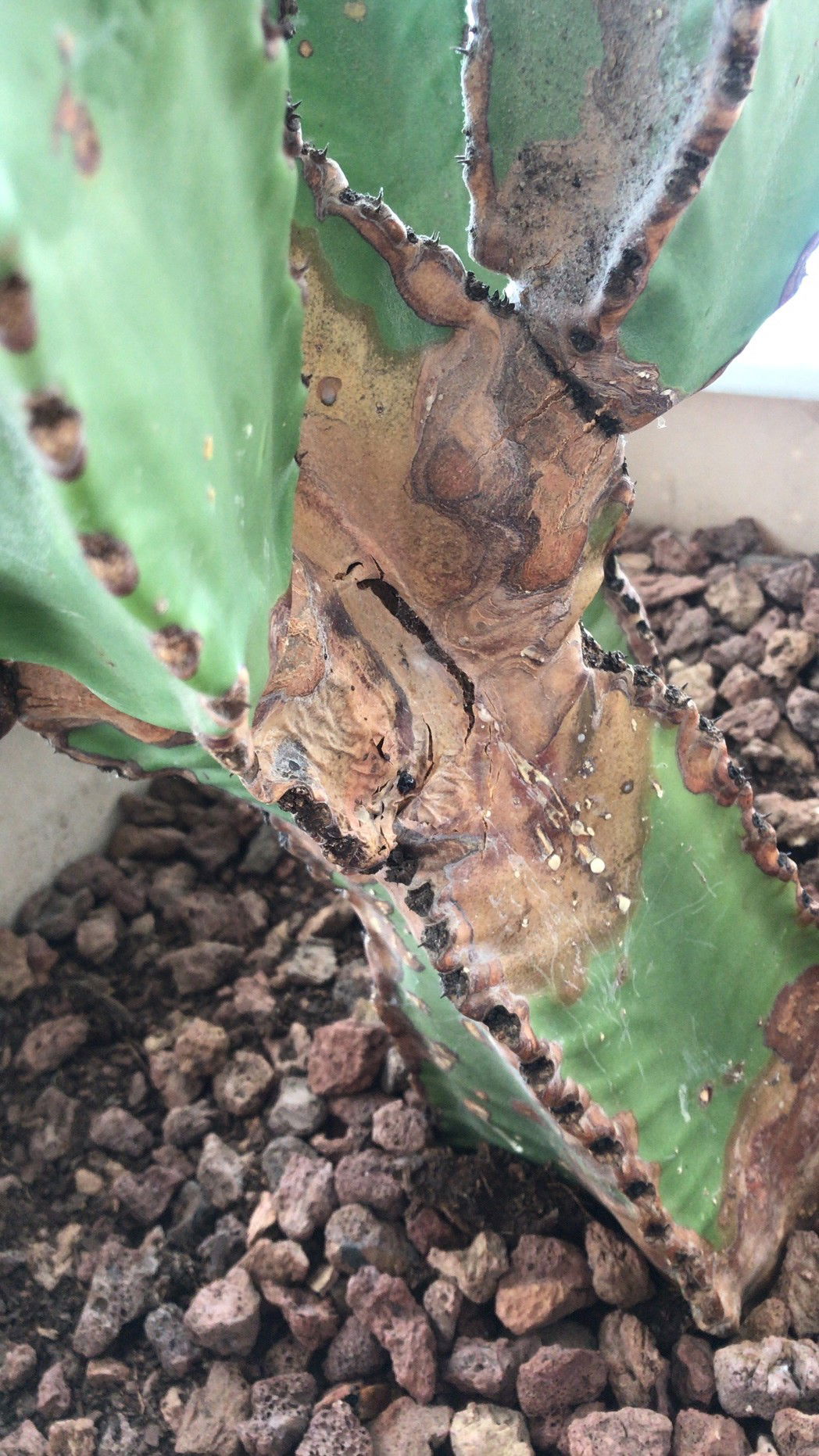 'Corking' is a natural process for many desert Cacti, proving support and a barrier against hungry predators.
'Corking' is a natural process for many desert Cacti, proving support and a barrier against hungry predators.
Origins
Cacti can occur in all shapes and sizes, ranging from the ‘Blossfeldia liliputana’ that measures only 12mm in diameter, to the classic Saguaro that can reach in excess of over 12m. The largest cactus ever recorded was a Pachycereus, which blew over during a heavy windstorm in the mid-1980s. His height? Twenty-three metres!
Although Cacti have been used for medicinal and decorative purposes for over six hundred years, drawings and other findings can back to 9'000 years ago. Almost all of the 1,750-known species originate from the Americas, with only the Rhipsalis baccifera (Africa) breaking this trend. The formal classification of Cacti arose in the 1730s by Carl Linnaeus, who placed the species he knew into two groups - Cactus & Pereskia. Before his book was published in 1753, he re-conjoined the two groups back into Cactus, a Greek word that was first used by Theophrastus (A Greek Philosopher, C. 300BC), describing a 'thornful' plant.
Further Facts about the Popular Genera
- Mammillaria - A genus of small-sized Cacti that originates largely from Mexico, classified by Carl Linnaeus in 1753, using the Latin word 'mammilla' (nipple) in reference to its tubercles.
- Peyote - First described in the late 19th century by John Coulter, using the Spanish word for 'glistening' referring to their epidermal appearance. They can grow up to 30cm tall in their natural habitats of Texas and obtains psychoactive properties which can last over 12hrs when digested.
- Echinocactus - Part of the Barrel Cactus family (alongside Ferocactus) originating from northern Mexico. When established, they can reach heights of 3m in clusters of spherical offshoots. The genus was first described in Johann Link in the early 19th century, using the Greek word for 'spiny' ('echino') and 'Cactus' that was first used by Carl Linnaeus a century prior.
- Neoraimondia (Neocardenasia) - A genus of large cacti that originate from Peru, named in honour of Italian explorer, Antonio Raimondi in the 19th century.
- Espostoa - A Peruvian genus of edible-fruiting cacti that was first classified in the late 19th century, in honour of Botanist Nicolas E. Esposto. They can reach heights of 5m, forming cephalic white hairs along the areoles - (similarly to the Old Man's Cactus pictured above).
- Cereus - Can be translated to 'wax' in Latin, referring to the shiny nature of most species. They originate mostly from eastern South America and can reach heights of 10m.
- Echinocereus - Similarly to the genus above, Echinocacti can reach heights of 10m and naturally occur in Mexico. 'Echino' can be translated from Latin meaning 'Hedgehog', which is in reference to the spiny nature of their appearance.
- Pilosocereus - Many of the species that originally were placed in this genus had hair like appearances, similarly to Echinocereus and Espostoa. This is where the epithet 'Piloso' (translating to 'hairy' in Latin) first came about. Unfortunately in the last century, most of the species have been reclassified despite the genus' name staying the same. They can reach up to 6m in height when grown in their natural habitat of South America.
Temperature
10° - 28°C (50° - 82°F)
H1c - Can be grown outdoors in the spring and summer in a sheltered location once the nighttime tempreetres are above 10°C. Always perform a pest-check before re-introducing back into the home to avoid an infestation with other plants - most common to look out for are Mealybugs and Vine Weevils.
Reducing this temperate to around 12°C (54°F) during the autumn and winter months will not only help its its dormancy period, but it'll also increase the chance of a bloom in the spring or summer.
Spread
Fast Growth Rate - Saguaro Cactus, (Carnegiea gigantea), Euphorbia & Bilberry Cactus.
Slowest Growth Rate - Golden Barrel Cactus, Mammillaria, Aztekium, Ferocactus, Vatricania & Peyote.
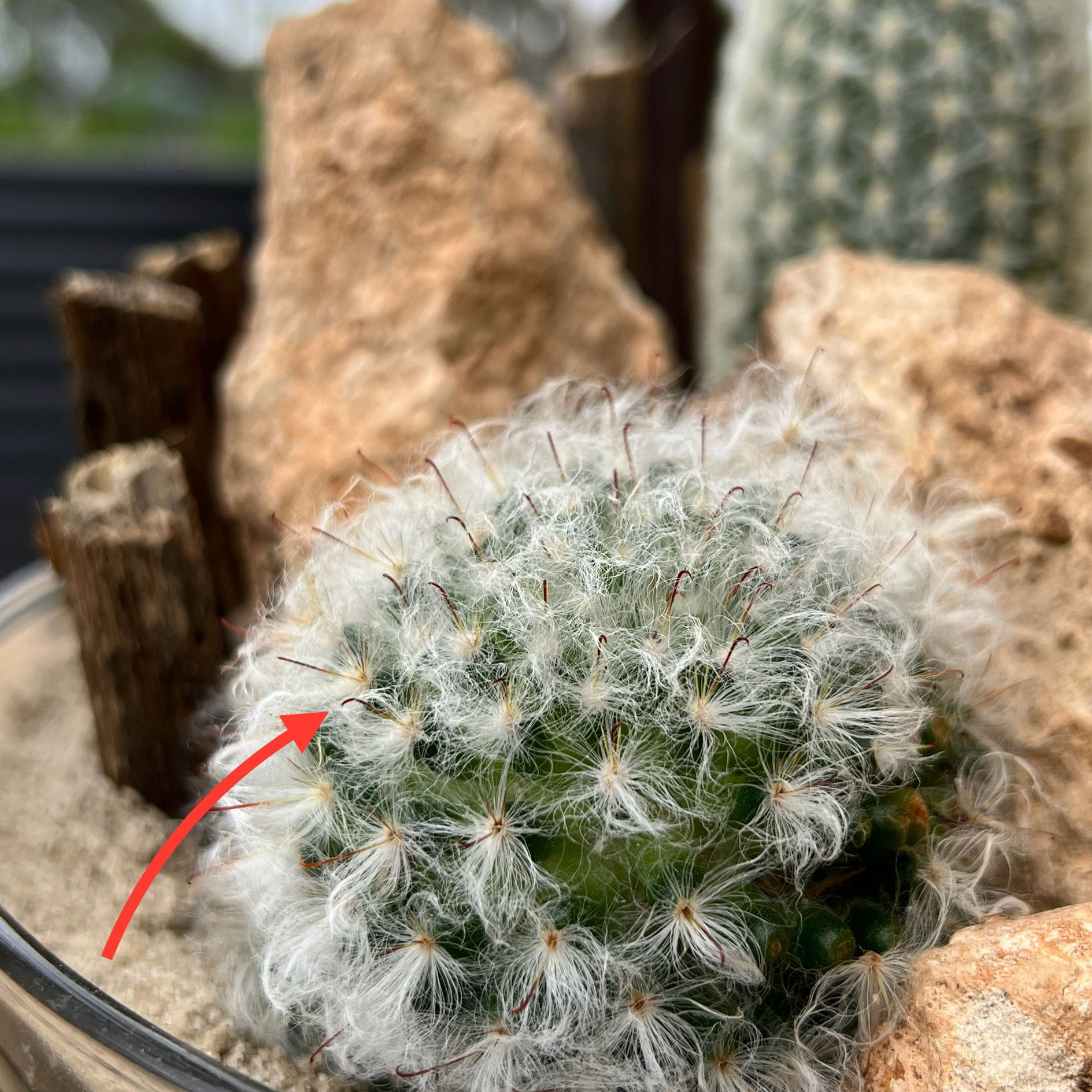 Some Cacti have hooked thorns to warn nearby predators like this Mammillaria bocasana var. splendens.
Some Cacti have hooked thorns to warn nearby predators like this Mammillaria bocasana var. splendens.
 And others ramble along the ground in search of moisture and protection from the sun.
And others ramble along the ground in search of moisture and protection from the sun.
Pruning & Maintenance
Remove yellowed or dying leaves and plant debris to encourage better growth and improve the all-round appearance. Pruning must be done with clean scissors or shears to reduce the chance of bacterial and fungal diseases; remember to make clean incisions as too much damage can shock the plant.
In some cases, you can even graft epiphytic (tropical) Cacti into terrestrial desert species. Have a look at the strange image below to be amazed!
Propagation
Via Seed or Offset Division via 'Pups' or Leaf Cuttings.
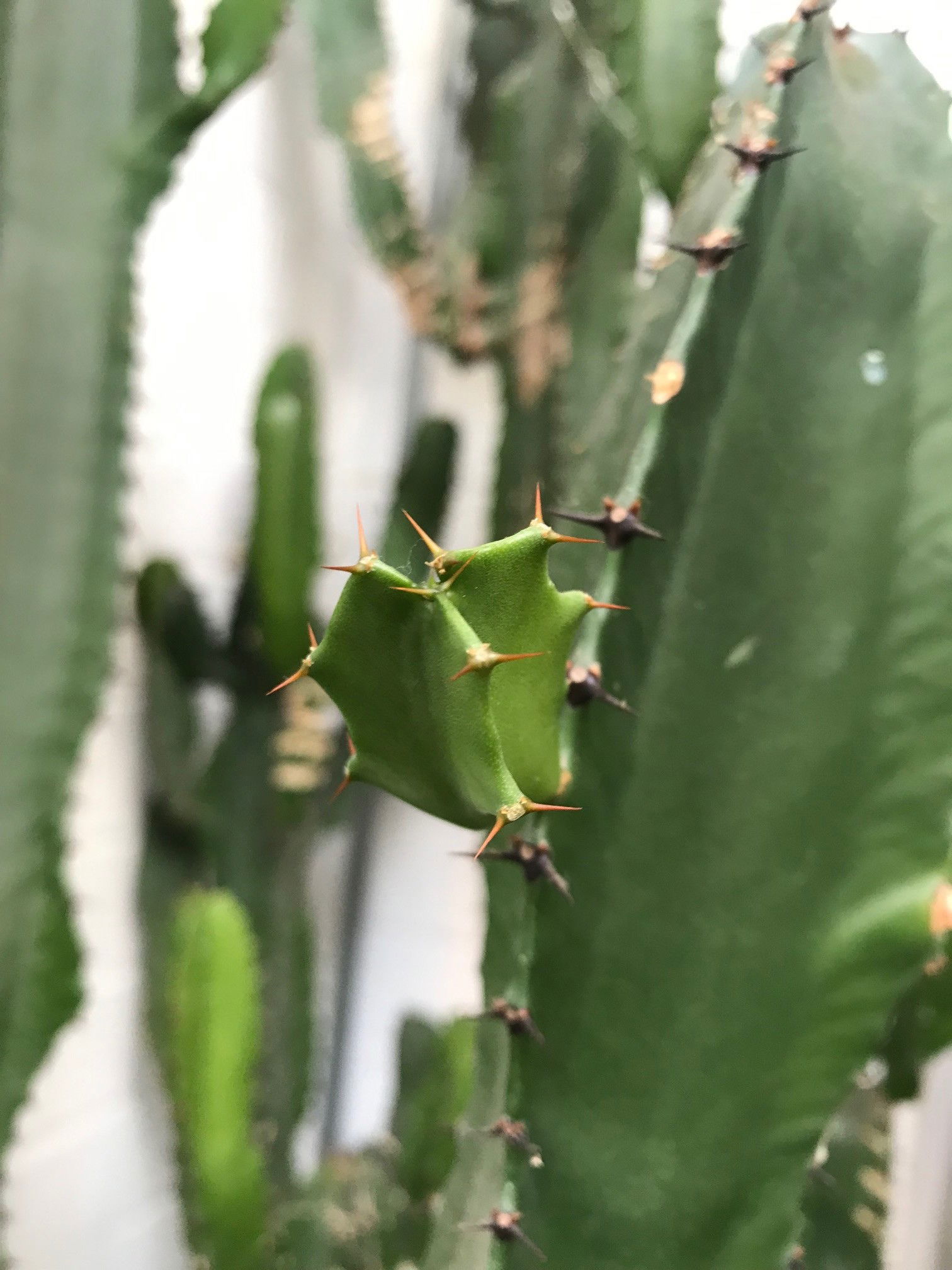 An Euphorbia trigona lateral offshoot that can be propagated into its own plant.
An Euphorbia trigona lateral offshoot that can be propagated into its own plant.
Lateral offshoots (Pup) Division - Some species, like Euphorbia, Opuntia, Gymnocalycium, will produce lateral growths that can be propagated in the spring, once they surpass 7cm in length. Wear some protective gloves and place your hand in between the two. While placing your hand closely to the nodal junction, gently push the pup downwards, while supporting the mother plant - you should hear a snap. Cautiously separate both the mother plant and pup's roots systems, keeping great empathise in keeping the roots intact and damage-free. Place the new plantlet a third depth in a moist 'Cactus & Succulent' labelled mix, much similar to the original soil, and maintain the same care routines. Don't worry if the 'pup' doesn't have any roots, these will form later down the line. Make sure not to use a pot that is too big as a ratio of roots-soil that leans towards the latter will cause root rot and eventually plant death. Keep the soil dry and out of direct sunlight for the first two months. When the pup is rooted, increase the light intensity and frequency of waters.
Repotting
Repot every three years in spring using a 'Cactus & Succulent' labelled potting mix and the next sized pot with adequate drainage. Cacti are far better being potbound for several years due to the heightened risk of root rot and repotting-issues (like transplant shock), so only repot if you feel it's wholly necessary - restricted root growth will also increase the chance of blooms, too.
Hydrate the plant 24hrs before the tinkering with the roots to prevent the risk of transplant shock. For those situated in a darker location, introduce an extra amount of perlite and grit into the deeper portion of the pot to downplay over-watering risks. Click on this link for a detailed step-by-step guide on transplantation, or via this link to learn about repotting with root rot.
Book a 1-to-1 video call with Joe Bagley if you'd like a personal guide to repotting your houseplant. This will include recommending the right branded-compost and pot size, followed by a live video call whilst you transplant the specimen for step-by-step guidance and answer any further questions!
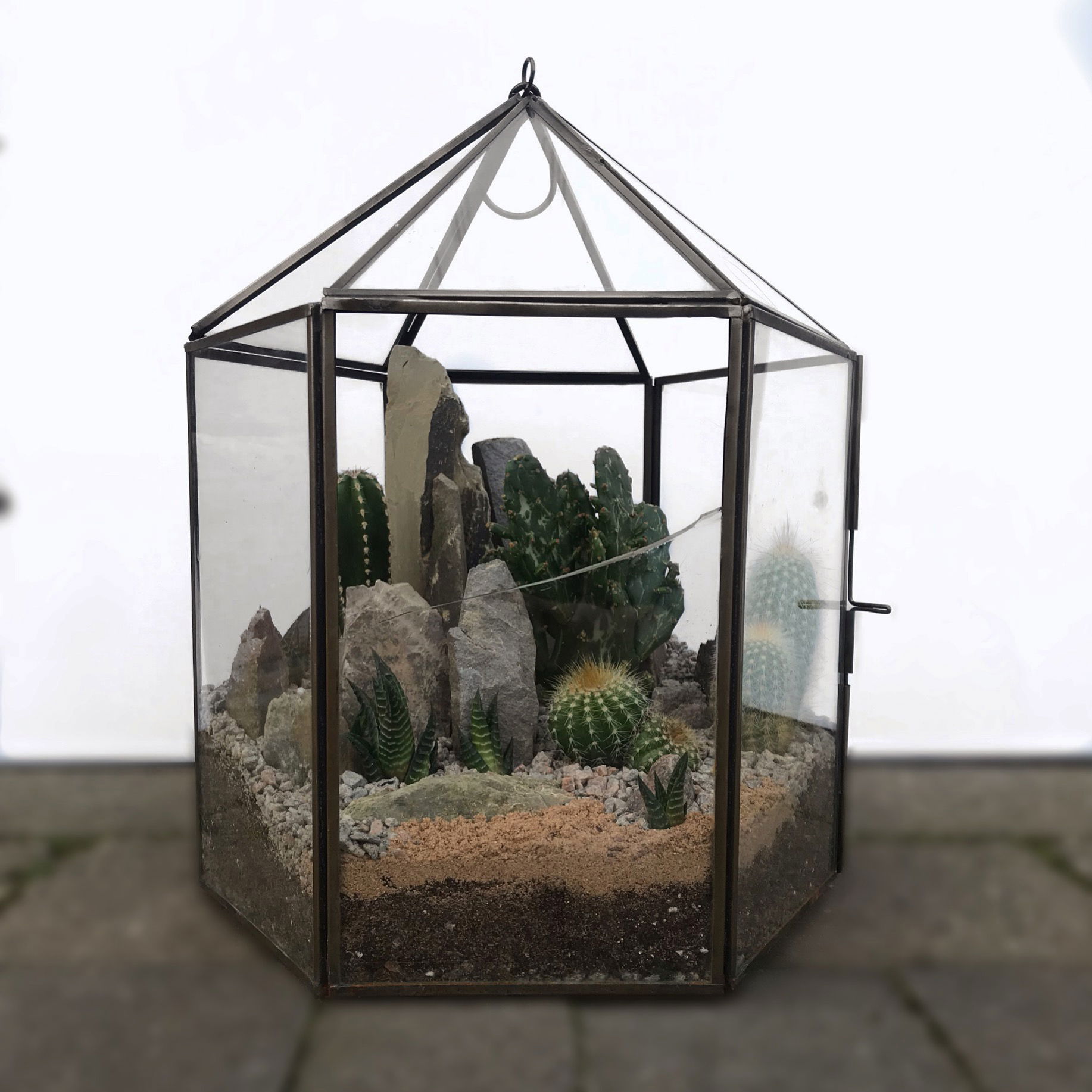 Instead of repotting your Cactus in the next sized pot, why not create a stunning terrarium like this one?!
Instead of repotting your Cactus in the next sized pot, why not create a stunning terrarium like this one?!
Pests & Diseases
Keep an eye out for vine weevils (uncommon indoors), spider mites, scale & mealybugs. For more info on how to address any of these issues, hit this link. Common diseases with Cacti are root, crown or heart rot, sun-scald, soft rot, scabs, nematodes, leaf-spot disease and powdery mildew. Identifying Common Houseplant Diseases & Viruses
Toxicity
Most species are classified as poisonous. If parts of the plants are eaten, vomiting, nausea and a loss of appetite could occur. Consumption of large quantities must be dealt with quickly; acquire medical assistance for further information.
Retail Locations
Most Garden Centres or Florists, & Online.
Book a 1-to-1 Call with Joe Bagley
If you need further advice with your houseplants, book an advice call with ukhouseplants' friendly and expert writer today! This can be done via a video or audio call on most apps, including Facebook, FaceTime & Skype. A ten-minute call costs £5.99 (US$7), or £15.99 for thirty minutes. You can ask multiple questions, including queries on plants, pests, terrariums, repotting advice and anything in between. Please consider supporting this service to keep ukhouseplants thriving!

